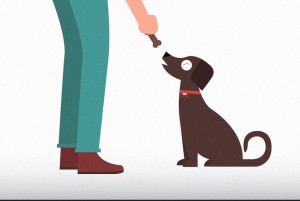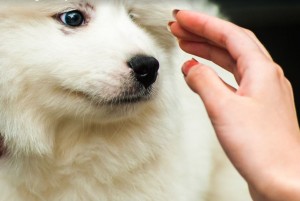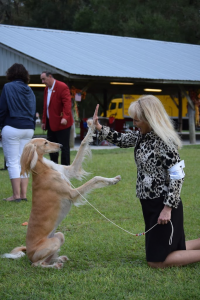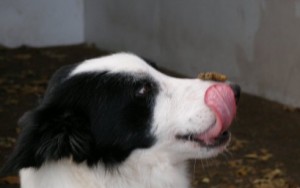Never Fear
By Caroline Coile Ph.D.
Meet Jake. He gave up on a dog show career because he won’t let the judge touch him. He’s so afraid of the vet that he has to be held down and muzzled to take blood. But at home he’s a great dog. Too bad nobody else ever gets to see it.
“He hates the vet’s/dog shows/public places/fill in the blank.” “He had a bad experience with a man/a woman in a hat/ he was abused/fill in the blank.” “He’s scared of strangers/men/loud noises/fill in the blank.” So your show dog stays home, your sick dog goes untreated, and both of you miss out on all sorts of great adventures. Just because your dog’s fears are dictating your lives.
Jake came from a good breeder. He was socialized right on schedule. His littermates are fearless. What’s his problem?
Dogs can be fearful for several reasons. They may be genetically predisposed, they may have been poorly socialized, or they may have had a traumatic event during a critical period. A dog with a specific fear is more likely suffering the consequences of a specific event, and is the most likely to be helped through behavior modification. A dog with generalized fear more likely has a genetic predisposition and is the least likely to profit from training. That doesn’t mean you should give up. Living in fear robs you and your dog from engaging in lots of normal fun activities, and puts your dog at risk for panic running, fear biting, and high stress levels.
Jake’s owners are being flooded with advice. Much of it was learned from watching television. Most of it is wrong. Did I mention they were being flooded with advice? That’s a clue.
Say No to Flooding: Flooding is a type of training in which you are innundated with whatever scares you. Yeah, that should work. Think back to the adaptive value of fear. Forming associations between certain events and painful or threatening outcomes is necessary for survival. Fearless dogs are called dead dogs. Ideally, for example, if a dog hears a car horn right before he gets hit by a car, if he’s lucky and lives he’ll learn to fear car horns and respect cars. He won’t be terrified of cars because he will be able to move out of their path, and he’ll realize they pretty much ignore him if he gets out of the way. Problems arise when the dog has no such control over its environment. If he were forced to stand in the middle of the road with cars coming at him blowing their horns he would be terrified, and would remain terrified of cars and horns.
Yet most dog people have been advised at some point to do a version of this with their dog. I overheard a judge once advising a person with a scared dog to take him to a gas station, crate him next to the pumps, and leave him there all day so he would get used to people greeting him!
More often the traditional advice is to take the dog to a shopping center and have as many people as possible pet him, holding him in place if necessary. This is akin to staking the dog that was hit by a car in the middle of the highway. The dog has no control over his own well-being, and having no control increases his anxiety and fear.
This practice of “flooding” doesn’t work for a couple of reasons. First, the dog’s lack of control over the situation. Dogs with a history of being able to exert control over their own lives tend to be more confident and more resistant to fear than dogs without such a history. Dogs can be given control by rewarding them for good behaviors that they initiate, for example, by rewarding offered tricks or simply by being well-mannered.
Second, flooding depends on the dog becoming so habituated to the fearful stimulus that he can no longer maintain his level of fearfulness. Few people have that much time. They go to the shopping center, or the dog show, for an hour of “socializing” (or tormenting, in the dog’s view), and while the dog eventually may give up his attempts to escape, he probably hasn’t given up his fear. He leaves the situation having learned that he can’t escape from these people who have an unnatural interest in him, his owner won’t help him, and being there is a very scary place to be. When he returns the following week for round two, he’s even more scared. If you continue to flood him for short periods in which his fear never subsides, you’re likely to make it even worse. Think of it this way: If your child were afraid of heights, how effective do you think dangling her from a rooftop for an hour at a time once a week would be? (Hint: not very).
A Little at a Time: Rather than dangling your child off the 20th story, wouldn’t it be better to start by having her look out the 2nd story window? Rather than starting by taking your dog to a parade, wouldn’t it better to start by taking him on a walk with one other person? That’s the idea behind gradual desensitizing.
Your goal is to help your dog build his confidence and feeling of control in such a way that at the end of each session he is not fearful. You do this by combining several behavioral techniques.
1) Response prevention: Although you want your dog to learn to have some control, you don’t want him to learn that his control is through escape or biting. Prevent such behaviors but give him some way of earning his way to a point farther from the stimulus. For example, have him do a trick and reward by walking away from what he fears for a minute. Allow the person to touch him, then reward by letting him walk away.
2) Gradual desensitization: Your goal is to start each session at a level that may cause some anxiety to your dog, but not so much that the dog is still fearful at that level at the end of the session. That may mean that instead of walking into the veterinary clinic or dog show, you just walk around the perimeter the first day. Only advance one step closer when your dog is at ease at the previous level. Remember, your dog is learning to be calm. If he’s still afraid at the end of a session, all you have taught him is how to be scared.
3) Counterconditioning: Getting your dog to do something incompatible with fear, such as eating, playing or hunting will help him focus less on what he’s afraid of and associate good feelings with the situation. This is one reason taking your dog for a walk, or hunting, with another person is more helpful than meeting a stranger at a shopping center. Activities that tap your dog’s genetic heritage are especially good at this. Years ago studies with a genetically shy family of Pointers found that those allowed to hunt improved the most.
4) Imitation: Your dog won’t be helped if he sees other dogs acting fearful, but he might be encouraged to join in if his best doggy friend is getting petted and eating treats from somebody else. Don’t forget that your dog can cue off of you as well. Neither coddle nor punish him when he acts fearful. Instead, if something startling happens, act as though it’s funny; if a stranger appears, act like you’re glad.
5) Ignoring: Like shy children, dogs seem more afraid of the attention of a stranger than they are of the presence of a stranger. Have the stranger stand with her back to your dog so your dog can be the one to approach and sniff. The stranger shouldn’t talk to or reach for the dog. Only gradually should you get to the point where the person touches the dog first. During this time your dog may be confused about what to do. Remember, he needs the confidence of knowing he is doing the right thing, so now is a good time to reward him for doing some simple tricks. Often a dog told to sit and stay will tolerate the approach of a stranger better than one given no directions.
 Putting these together, you can come up with a training plan in which you will very gradually expose your dog to strangers, having your dog do something incompatible with being fearful, and asking your dog to do some simple tricks in exchange for food or play rewards.
Putting these together, you can come up with a training plan in which you will very gradually expose your dog to strangers, having your dog do something incompatible with being fearful, and asking your dog to do some simple tricks in exchange for food or play rewards.
Less is More: Part of your challenge will be to avoid well-meaning people who don’t understand that less is more. You have to avoid the “All dogs like me!” guy who thinks he will singlehandedly turn your dog around. Avoid the well-meaning handler who insists on giving your dog a full-cavity search because you asked them if they could go over him quickly before you go in the ring. Avoid the parent who calls her 10 kids over to pet your dog just because you asked her to pet him. All of these people, whether they realize it or not, are ascribing to the flooding method—and it won’t help.
Better Living Through Medicine: Many dogs never improve using traditional behavior modification because they never attain a calm enough state to build on. Giving them anti-anxiety drugs before training or before a scary event, like going to the vet, can help them dramatically. And while AKC rules prohibit the use of such drugs in the ring, they aren’t prohibited in dogs you’re just walking around the show for socialization. If you have access to a veterinarian train in fear-free methods, get her advice for the best drug to try. We’ve all been led to believe we should never give behavior-modifying medications to our dogs. Yet we take them all the time. Why should our dogs be forced to tough it out? Besides, since you’re their “supplier” they have little chance of getting “hooked.”
Meet Jake now. His owner used drugs to calm him enough he could gradually go to dog shows and the veterinary clinic without being so scared he couldn’t think. At first he was too nervous to eat or play, but he found his laser light toy irresistible, so his owner used it when it was dim enough he could play with it. He’d forget he was supposed to be scared and started chasing it. Eventually he chased some of his other favorite toys. He got so he was fine walking around the show or clinic as long as nobody paid any attention to him. But he hated when people approached him. So Jake’s owner made sure to walk away from strangers who might overwhelm him, and asked trusted people to ignore him, even turn away from him, while they chatted. He got so he was fine, even sniffed them from behind, but when they turned around he wasn’t so sure. His owner asked them to walk with them, and Jake liked this just fine. She even had her neighbors share their evening stroll (and made new friends in the process!). When it came time for them to pay attention to Jake, she had Jake do one of his easiest tricks. By this time he was relaxed enough he could eat treats, so at first she, then the friend, rewarded him. Next the friend had him do the same trick, and gave him the reward. Finally the trick he had to learn was to let the friend, and eventually, stranger, touch him, while he was in a show pose and in a veterinary exam sit. It didn’t happen overnight. But now Jake is a champion. And he’s also a champion patient.
Now Jake is fear-free—and no longer do his fears rule his family’s lives.
Short URL: https://caninechronicle.com/?p=149221
Comments are closed














